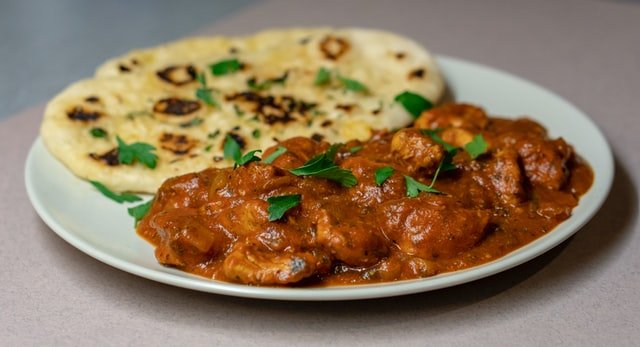Do you want to make your curries special? Do you want to turn the curry eating experience from a dull affair into something truly exciting? Then you need to be using madras curry powder.
Madras is a style of Indian cooking that originated in the state of Tamil Nadu on the southeast coast of India. It is not as well known as other styles, such as Korma, but it is gaining in popularity, and for good reason. Madras curries are bright and lively, with a bit more heat than many other varieties. The heat comes from the use of pepper rather than chili peppers, but it still packs quite a punch.
Madras curries are very good at bringing out the flavor of the meat or vegetables they accompany, so most dishes call for generous amounts of onions and garlic. This is true even if they are using seafood or paneer instead of meat. Garam masala, which is a spice blend that includes cumin, cinnamon, cloves and other warm spices, is also used in madras curries. It complements the pepper nicely and gives the dish an earthy quality.
The use of pepper makes these curries stand out from their counterparts. In many Indian dishes the heat comes from chili peppers or chilies.
Madras curry powder typically contains coriander, turmeric, cumin, fenugreek, and chili peppers.
The history of this blend, like many things culinary, is a matter of debate. Some claim that it was invented by the British in colonial India to make the traditional regional curries of India more spicy and appealing to British tastes. Others claim that it was actually invented in England, which seems counterintuitive but makes sense when you remember how much the English love their mulligatawny soup.
Taste-wise, madras curry powder is best suited to medium-heat dishes. Because it has a lot of turmeric in it, it has a distinct yellow color that might not be what you’re looking for if you’re making something with a creamy sauce or using it with seafood. It should go great in a stir fry or on top of chicken tikka masala. It also goes well with potatoes and eggplant. Mixing it with some mustard seeds can give your dish an extra kick without being overpowering.*
In addition to its culinary uses, madras curry powder is an excellent source of vitamin C.*
Madras curry powder is a spice blend that includes turmeric, coriander, cumin, and black pepper as well as other spices such as chili peppers. It is one of the most common spice mixes used in Indian cooking and even has its own Wikipedia page.
It is also one that you should be using when you make curry at home.
Madras curry powder is a special blend of spices used to flavor Indian cuisine. The term “Madras” refers to the city of Madras, where the blend originated in the second half of the 18th century. There are numerous variations of the Madras curry powder recipe, but they all include turmeric, coriander, cumin, and fenugreek.
Taste-wise, Madras curry powder is very hot and bitter. That’s why it’s usually mixed with other milder spices such as garam masala or curry powder when cooking. It’s also one of the most commonly used blends for making vindaloo, a traditional Indian dish that is known for its fiery nature.
The wonderful thing about curry powder is that it can be made into pretty much whatever you have in the house. Want to make a spicy Indian curry? Add some coriander, cumin, turmeric and mustard seeds. Looking for a Thai curry with peanuts and lemongrass? A Caribbean stew with allspice, cloves and pumpkin? In the mood for a more classic British curry powder? Try adding cinnamon, nutmeg and mace.
Thing is, it’s not quite as simple as just combining the above spices together: you want to use different quantities of each spice depending on what type of dish you’re making. For example, if you’re making a dry rub for chicken or steak (think balti), then you’ll only want to use half a teaspoon of salt because the main purpose of your curry powder isn’t to make the food salty but to add flavour. If you’re making a sauce, however, then add 2 tbsp of water to make sure that everything mixes together well before adding your chicken or fish.
And then there’s the matter of consistency: do you want it smooth or chunky? A fine powder will mix easier into your dish but won’t have any texture; chunky sauces are great on rice but can be
Curry is a British dish that may have originated in India. It is made with curry powder, which is a combination of spices. The curry powder recipe varies by the chef or restaurant. There are many recipes for curry including chicken tikka masala and shrimp vindaloo. Curry leaves and garam masala are added to the dish to enhance its flavor.
Tumeric and ground coriander are two ingredients used in many curries. Turmeric is a popular Indian spice that helps in digestion. Coriander has an earthy taste but can also be peppery when fresh. Coriander also contains antioxidant properties, according to the University of Maryland Medical Center.
One of the most popular variations of curry is madras curry powder due to its spicy taste and deep red color from the addition of dried red chilies. Madras curry powder is a combination of spices, cumin, coriander, mustard seeds, pepper, fenugreek seeds and cinnamon among others.
Curry powder can be made at home using whole spices such as cardamom seeds, cloves, caraway seeds, cinnamon sticks and peppercorns or dry roasted ingredients such as coriander seeds and cumin seeds. Combining whole spices to create a curry powder
It’s a bit of a misnomer. First, because it’s not even originally from Madras (it’s from Sri Lanka), and second, because it’s not one spice but four: coriander, cumin, black pepper and turmeric. The first three are all seeds, the last a rhizome — the root of a plant — giving the spice mix a distinctive smell and color.
Tumeric is the most interesting of these spices. It’s what gives your curry powder that beautiful yellow-orange color and it’s also what rounds out the other three spices to create something fragrant and mellow instead of just pungent.

